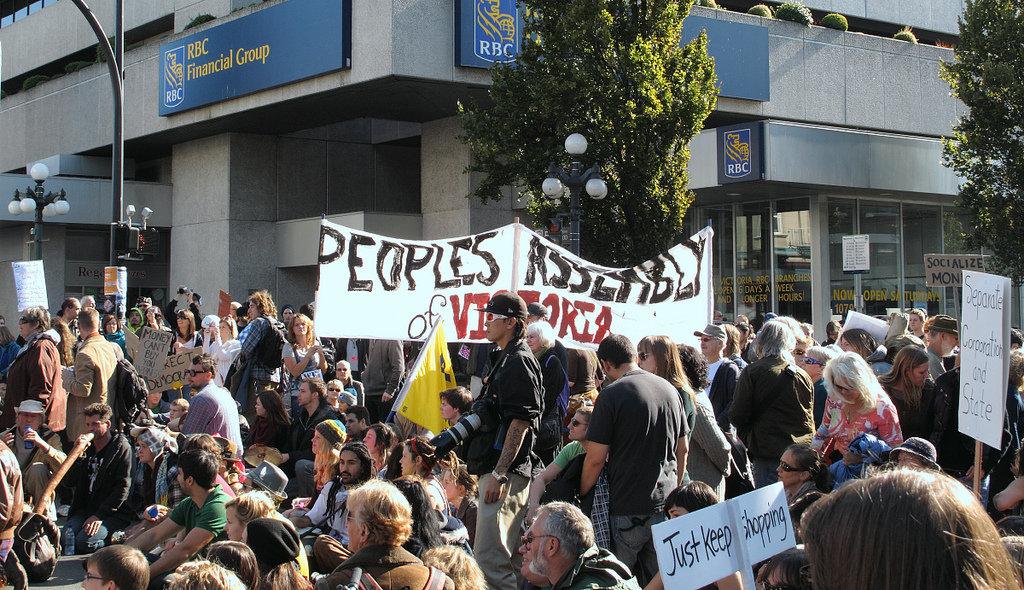
Learning Objectives
- Understand Simmel’s argument “there is no such thing as society as such.”
- Distinguish the forms and contents of social interactions.
- Situate sociological structures within three levels of analysis: micro, meso, and macro.
- Analyze the operation of a group as more than the sum of its parts.
- Understand primary and secondary groups as two key sociological groups.
- Recognize in-groups, out-groups, and reference groups as subtypes of primary and secondary groups.
- Distinguish between different styles of leadership.
- Explain how conformity is impacted by group membership.
- Distinguish between groups, social networks, and formal organizations.
- Analyze the dynamics of dyads, triads, and larger social networks.
- Categorize the different types of formal organizations.
- Define the characteristics of bureaucracies.
- Analyze the opposing tendencies of bureaucracy toward efficiency and inefficiency.
- Identify the concepts of the McDonaldization of society and the McJob as aspects of the process of rationalization.
- Apply the sociological study of groups and bureaucracies to analyze the social conditions of the Holocaust.
Introduction to Groups and Organizations
The punk band NOFX is playing outside in Los Angeles. The music is loud, the crowd pumped up and excited. But neither the lyrics nor the people in the audience are quite what you might expect. Mixed in with the punks and young rebel students are members of local unions, from well-dressed teachers to more grizzled labour leaders. The lyrics are not published anywhere but are available on YouTube: “We’re here to represent/The 99 percent/Occupy, occupy, occupy.” The song: “Wouldn’t It Be Nice If Every Movement Had a Theme Song” (Cabrel, 2011).
The slogan, “We are the 99%,” emblematic of the Occupy movement that flourished in North America in 2011 and 2012, refers to the redistribution of wealth from the middle class to the upper class (the “one percenters”). Even during the severe economic crisis after 2008, the personal income, bonuses, and overall share of social wealth of the elite 1% increased. Occupiers observed that the very people responsible for the crisis and the massive loss of wealth in the economy were paying themselves bonuses for a job well done, even while they were receiving billions of dollars in bailouts from the government. This would seem to be a grievance worthy of a movement, but simply having a grievance does not explain the ways in which movements take form as groups.
In Victoria, B.C., a tent community sprang up in Centennial Square outside city hall, just like tent cities in other parts of the country. Through the “horizontal decision-making process” of daily general assemblies, the community decided to change its name from Occupy Victoria to the People’s Assembly of Victoria because of the negative colonial connotations of the word “occupy” for Aboriginal members of the group. Occupy Montreal adopted the concept of stepping back or “progressive stack” in their meetings. Men and other dominant movement figures were encouraged to step back from monopolizing the conversation so that a diversity of opinions and experiences could be heard. As the tent cities of the Occupy movement began to be dismantled, forcibly in some cases, a separate movement, Idle No More, emerged to advocate for Aboriginal justice and organized itself according to Aboriginal principles of decentralized leadership. Horizontal decision making processes, progressive stack, and decentralized leadership refer to the different organizational structures these social movements experimented with in rethinking traditional hierarchical structures of organization.
Numerous groups made up the Occupy movement, yet there was no central movement leader. What makes a group something more than just a collection of people? How are leadership functions and styles established in a group dynamic? What unites the people protesting from New York City to Victoria, B.C.? Are homeless people truly aligned with law school students? Do Aboriginal people genuinely feel for the environmental protests against pipelines and fish farming? How does a non-hierarchical organization work? How is the social order of a diverse group maintained when there are no formal regulations in place? What are the implicit or tacit rules that such groups rely on? How do members come to share a common set of meanings concerning what the movement is about?
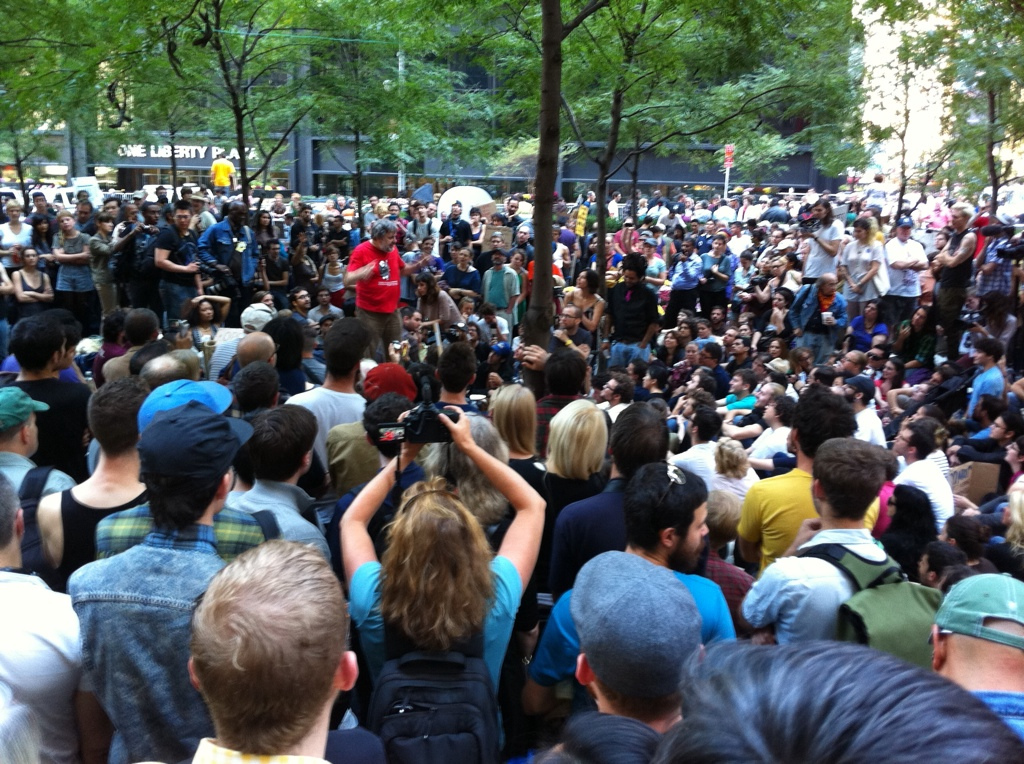
At one point during the occupation of Wall Street in New York, speakers like Slovenian social critic and philosopher Slavoj Žižek were obliged to abandon the use of microphones and amplification to comply with noise bylaws. They gave their speeches one line at a time and the people within earshot repeated the lines so that those further away could hear. How did this communicational format, despite its cumbersome nature, come to be an expression of the group’s solidarity?
6.1. How is Society Possible?
One of the basic questions raised in sociology is: How is society possible? What holds society together? What gives society form and continuity? This was the classical sociologist Georg Simmel’s basic question. In his essay, “The Problem of Sociology,” Simmel (1908/1971) begins by saying: “Society exists where a number of individuals enter into interaction.” This would appear to be a truism. After all, what else could society be? However, a few pages later, he reaches the conclusion that:
With each formation of parties, with each joining for common tasks or in a common feeling or way of thinking, with each articulation of the distribution of positions of submission and domination, with each common meal, with each self-adornment for others — with every growth of new synthesizing phenomena such as these, the same group becomes “more society” than it was before. There is no such thing as society “as such”; that is, there is no society in the sense that it is the condition for the emergence of all these particular phenomena. For there is no such thing as interaction “as such” — there are only specific kinds of interaction. And it is with their emergence that society too emerges, for they are neither the cause nor the consequence of society but are, themselves, society. The fact that an extraordinary multitude and variety of interactions operate at any one moment has given a seemingly autonomous historical reality to the general concept of society (Simmel, 1908/1971, emphasis is the editor’s).
There is no such thing as society as such. There is no such thing as “society” outside of the interactions between the individuals that compose it. Society is the name we give to the “extraordinary multitude and variety” of specific interactions between individuals that are occurring at any particular moment.
If society is nothing but these simultaneous interactions, Simmel’s problem of sociology is clear. Sociology, as the “science of society,” appears to be a discipline without an object! Society is not an object or a thing; it is a mirage, a name we have given to the multitude of ongoing, unfinished processes of interaction between individuals. This means we have to ask the questions of sociology at a more basic level. How do these processes hold together and take shape? How are we able to recognize and talk about different social phenomena like the formation of parties, the joining together in common tasks, the creation of hierarchies, the wearing of jewellery, etc.? If society is nothing but a number of individuals who have entered into specific interactions, how do widespread norms of behaviour, structured relations of power, and predictable relationships between social variables form?

Punk rock in the 1970s saw itself returning to the roots of rock and roll. Part of this was to simplify the structure of the music to renew rock and roll as a form of music. This is a good metaphor for how Simmel understands social interaction between individuals as both a mutual attunement and an act of creation. For a coherent interaction to take place, everyone tunes their instruments together (at least somewhat) and plays the same notes and chords. However, this attunement also enables everyone to introduce new elements into the interaction and to invent new musical or social forms (or renew old ones). Along with the new musical form of punk rock came new lyrical and thematic contents: anger, disillusionment, anarchy, class politics, etc.
Simmel’s solution to the problem of how society is possible is based on the idea that the mutual influence of individuals on each other during interaction creates mutual attunements, not unlike a band tuning its instruments. This mutual influence in turn creates enduring social forms (hence the term formal sociology to describe Simmel’s work). We will discuss Simmel’s formal sociology later in the chapter. In general, however, the solution to the question — How is society possible? — differs depending on the level of analysis used to pose the question. Excluding the global for the time being, sociologists describe three levels of social interaction: micro, meso, and macro.
Micro Meso Macro
At the micro-level of analysis, the focus is on the social dynamics of face-to-face interaction: How are specific individuals in specific locations able to interact in a coherent and consistent manner? For example, how is a conversation possible? How do you know when it is your turn to speak or when someone has been speaking too long? We discussed various types of social interaction at the micro-level in the chapter on social interaction.
At the meso-level of analysis, the focus shifts to the characteristics of specific networks, groups, and organizations (i.e., collectivities). The meso-level refers to the connection, interaction and ongoing coordination of numerous different social roles simultaneously. When we speak of a school, for example, we need to move beyond the analysis of single face-to-face interactions–interactions in a single setting where participants are co-present–to examine the combined interactions and relationships between students, parents, teachers, and administrators. At this level, we ask, how do the properties of different types of social collectivity affect or alter the behaviour of individuals? Why does an individual’s behaviour change when they are in a collectivity? How do collectivities constrain or enable their members to act in certain ways? What is it about collectivities that entice people to conform? In these meso-level examples we are still talking about specific, identifiable individuals–albeit not necessarily in direct face-to-face situations–but take into account the complex entwinement of their lives to account for their behaviour.
Finally, at the macro-level of analysis, the focus is on the properties of large-scale, society-wide social interactions: the dynamics of institutions, classes, or whole societies. The macro therefore extends beyond the immediate milieu or direct experience of individuals. These large-scale social structures might be nothing more than the aggregations of specific interactions between individuals at any particular moment as Simmel argues. However, the properties of structures, institutions, and societies — described by statistical analysis, cross-cultural comparisons, or historical research — also have a reality that Emile Durkheim called sui generis (i.e., of their own kind). The properties that make society possible at a macro scale cannot be explained by, or reduced to, their components without missing their most important features.

To illustrate the micro, meso, and macro distinction, we might consider how a sociologist would analyze the game of hockey. At the micro-level of analysis, the sociologist would be interested in the interpersonal structures and role-play that governs how various specific individuals (players, coaches, managers, owners, fans, etc.) interact face to face. With respect to the players, how do they interact on the ice in a coherent manner? How do they coordinate their activities to win games? How do they make the game work? In part, this analysis is a matter of simply knowing the rules of the game and each player’s role or position (center, winger, defense, goalie). From a different angle, the analysis has to do with the players practicing the plays by which they move the puck out of the defensive zone, cross the blue line into the offensive zone, defend against offensive plays, cycle the puck behind the net, set up a power play, etc. From another angle, the analysis is also a matter of the personal dynamic between individual players, their ability to read each other’s cues, to anticipate each other’s moves, and to work off each other’s strengths, etc. (or the failure to do so). In this regard, hockey is an entirely symbolic interaction, which depends on individuals sending signals and interpreting signals. It is, after all, a game based on chasing a small disk of rubber around a frozen surface of ice. It is thoroughly symbolic.
At the meso-level of analysis, a sociologist takes into account group dynamics involving a number of different roles simultaneously such as team membership or fandom. How and why do fans get so emotionally involved in the fortunes of their favourite team? How do they sort themselves into categories — “true” fans and “occasional” fans — and with what consequences? How do team rivalries develop? Similarly, the sociologist might be interested in the hockey team as a type of institutional arrangement of roles that organizes its members by collectively defining roles, functions, norms, official rules, hierarchical relationships, and channels of communication, etc.
The meso-level sociologist might also be interested in trying to define what defines hockey as a type of activity — a “game.” Roger Caillois (1961) noted that games, or what Simmel called the “play forms” of association, constitute a separate and unique type of activity. We cross a boundary whenever we leave the ordinary world of everyday life to enter the zone of play. In particular, games are defined by six characteristics:
- They are free (playing cannot be obligatory),
- They are separate (play is distinct from ordinary life),
- They are uncertain (outcomes cannot be determined in advance),
- They are unproductive (play by itself creates neither goods nor wealth),
- They are governed by rules (under conventions that suspend ordinary laws), and
- They are make-believe (they partake in a second reality or a “free unreality”).
In part, due to the distinction between games and normal life, activities like the use of violence and the infliction of injury — that would be punishable by law off the ice — are events that are frequently celebrated (or at most deplored) when they occur on the ice. It is the status of hockey as a game that makes the issue of its violence both ambiguous and subject to arbitrary assessments and punishments.
At the macro-level of analysis, the sociologist would be interested in how hockey is structured by the type of society in which it is embedded. The Micmac game of wolchamaadijik, which is cited as an early stick and ball progenitor of Canadian hockey, was played in the context of ceremonial exchanges between native tribes (Rand, 2005). NHL hockey, on the other hand, is a capitalist enterprise, and as such, it takes the form of a commodity produced for sale on the market for profit. The commodity is the spectacle of the hockey game, which fans pay to see and advertisers pay to use as a vehicle for promoting their products. Therefore, the organization and dynamics of the sport are defined by the logic of capital as Marx defined it — a logic in which teams are competitive corporations that invest in their players like any other asset; in which team hometowns are assessed in terms of their viability as profitable markets (hence the oddity of having teams based in Florida or California where natural ice probably has not existed for 10,000 years); in which the logic of class struggle periodically leads to disruptions in play (such as lock-outs and strikes); and in which an elaborate set of regulations (like salary caps and organized draft picks) are instituted by the league to ensure the viability of the competition and manage the excesses and crises that are tendencies of capitalist accumulation.
Making Connections: Classical Sociologists
Georg Simmel and Formal Sociology

Georg Simmel (1858–1918) was an early German sociologist and contemporary of Max Weber. He developed what he called formal sociology, or the sociology of social forms, in order to understand how a collection of individuals driven by their own individualistic interests could coalesce into a group with common purposes that could persist and develop through time. When he said that “society exists where a number of individuals enter into interaction” (1908/1971), he meant that whenever people gather, something happens that would not have happened if the individuals had remained alone. They begin to “correlate their condition” with that of others. They influence others and are influenced in return. A “reciprocity of effects” or “reciprocal influence” occurs that Simmel calls “sociation.” People attune themselves to one another in a way that is very similar to musicians tuning their instruments to one another. A pattern or form of interaction emerges that begins to guide or coordinate the behaviour of the individuals.
Key to Simmel’s analysis is the distinction he makes between the contents and forms of sociation. Individuals enter into interaction on the basis of their specific drives, needs, purposes, or interests (erotic, spiritual, acquisitive, defensive, playful, etc.). He defines these specific factors as the contents of the interaction. As Simmel says, “In themselves, these materials which fill life, these motivations which propel it, are not social… strictly speaking”(1908/1971). It is “only when they transform the mere aggregation of isolated individuals into specific forms of being with and for one another… in which individuals grow together into a unity and within which their interests are realized” that these contents become social (emphasis is the editor’s).
Therefore, the forms of sociation are the true objects of sociology because only through these forms can the social (i.e., “reciprocal influence”) be said to exist. Simmel (1908/1971) notes that innumerable types of forms are possible, including “superiority, subordination, competition, division of labour, formation of parties, representation, inner solidarity coupled with exclusiveness from the outside,” etc. These forms are the patterns of behaviour that guide individuals’ actions in different social settings. Therefore, his analysis shifts from the micro-level to the meso- and macro-levels when he posits how the forms themselves endure and work on the individuals who compose them.
An example Simmel uses is of a cocktail party where a subtle set of instructions begins to emerge which defines what can and cannot be said. In a cocktail party where the conversation is light and witty, the effect would be jarring if someone suddenly tried to sell you an insurance policy or confided about the spousal abuse they had suffered. The person would be thought of as being crass or inappropriate. Similarly, in the pleasant pastime of flirtation, if one of the parties began to press the other to consummate the flirtation by having sex, the flirtation would be over. Flirtation is a form of interaction in which the answer to the question of having sex — yes or no — is perpetually suspended.

In both examples, Simmel argued that the social interaction had taken on a specific form. Both were examples of what he called the play form of social interaction, or pure sociability: the pleasure people experience from the mere fact of being together, regardless of the content of the interaction (Simmel, 1910/1971). If the cocktail party conversation suddenly turns to a business proposition or an overly personal confession, it is no longer playful. The underlying form of the interaction has been violated, even if the participants were not consciously aware that they had adopted a particular form of interaction.
Simmel proposed that sociology would be the study of the social forms that recur in different contexts and with different social contents. The same play form governs the interaction in two different contexts with two different contents of interaction: one is the free-ranging content of polite conversation (the cocktail party form); the other is sexual desire (the flirtation form). Different contents or interests can be realized in different forms and vice versa with quite different consequences for the individuals involved. The same erotic impulse (content) can be expressed through the forms of a flirtation, a casual sexual relationship, a dating relationship, a marriage, or a transaction with a prostitute. On the other hand, the same form of competition can organize the impulse to play hockey, to gain financially, to learn, or to dress stylishly. The emphasis on forms is why Simmel called his approach to the study of society “formal sociology.”
Simmel’s work on social forms was not just confined to micro-level interactions. He developed an analysis of the tragedy of culture in which he argued that the cultural creations of “subjective culture” — like the emergent social forms created by people in their face-to-face interactions, as well as the forms of art, music, literature, political analyses, etc. — tended to detach themselves from lived experience and become fixed and elaborated in the form of “objective culture” — the accumulated products of human cultural creation. There are intrinsic limits to an individual’s ability to assimilate, organize, appreciate, and make sense of these forms. As the quantity of objective culture increases and becomes more complex, it becomes progressively more alienating, incomprehensible, and overwhelming. It takes on a life of its own and the individual can no longer see him- or herself reflected in it. Music, for example, can be enriching, but going to an orchestral performance of contemporary music can often be baffling, as if you need an advanced music degree just to be able to understand that what you are hearing is music.
6.2. Groups
Most of us feel comfortable using the word “group” without giving it much thought. But what does it mean to be part of a group? The concept of a group is central to much of how we think about society and human interaction. As Georg Simmel (1858–1915) put it, “[s]ociety exists where a number of individuals enter into interaction” (1908/1950). Society exists in groups. For Simmel, society did not exist otherwise. What fascinated him was the way in which people mutually attune to one another to create relatively enduring forms. In a group, individuals behave differently than they would if they were alone. They conform, they resist, they forge alliances, they cooperate, they betray, they organize, they defer gratification, they show respect, they expect obedience, they share, they manipulate, etc. At this meso-level of interaction, being in a group changes their behaviour and their abilities. This is one of the founding insights of sociology: the whole is greater than the sum of its parts. The group has properties over and above the properties of its individual members. It has a reality sui generis, of its own kind. But how exactly does the whole come to be greater?
Defining a Group
How can we hone the meaning of the term group more precisely for sociological purposes? The term is an amorphous one and can refer to a wide variety of gatherings, from just two people (think about a “group project” in school when you partner with another student), a club, a regular gathering of friends, or people who work together or share a hobby. In short, the term refers to any collection of at least two people who interact with some frequency and who share a sense that their identity is somehow aligned with the group. Of course, every time people gather, they do not necessarily form a group. An audience assembled to watch a street performer is a one-time random gathering. Conservative-minded people who come together to vote in an election are not a group because the members do not necessarily interact with one another with some frequency. People who exist in the same place at the same time, but who do not interact or share a sense of identity — such as a bunch of people standing in line at Starbucks — are considered an aggregate, or a crowd. People who share similar characteristics but are not otherwise tied to one another in any way are considered a category.
An example of a category would be Millennials, the term given to all children born from approximately 1980 to 2000. Why are Millennials a category and not a group? Because while some of them may share a sense of identity, they do not, as a whole, interact frequently with each other.
Interestingly, people within an aggregate or category can become a group. During disasters, people in a neighbourhood (an aggregate) who did not know each other might become friendly and depend on each other at the local shelter. After the disaster ends and the people go back to simply living near each other, the feeling of cohesiveness may last since they have all shared an experience. They might remain a group, practising emergency readiness, coordinating supplies for the next emergency, or taking turns caring for neighbours who need extra help. Similarly, there may be many groups within a single category. Consider teachers, for example. Within this category, groups may exist like teachers’ unions, teachers who coach, or staff members who are involved with the school board.
Types of Groups
Sociologist Charles Horton Cooley (1864–1929) suggested that groups can broadly be divided into two categories: primary groups and secondary groups (Cooley, 1909/1963). According to Cooley, primary groups play the most critical role in our lives. The primary group is usually fairly small and is made up of individuals who generally engage face-to-face in long-term, emotional ways. This group serves emotional needs: expressive functions rather than pragmatic ones. The primary group is usually made up of significant others — those individuals who have the most impact on our socialization. The best example of a primary group is the family.
Secondary groups are often larger and impersonal. They may also be task-focused and time-limited. These groups serve an instrumental function rather than an expressive one, meaning that their role is more goal- or task-oriented than emotional. A classroom or office can be an example of a secondary group. Neither primary nor secondary groups are bound by strict definitions or set limits. In fact, people can move from one group to another. A graduate seminar, for example, can start as a secondary group focused on the class at hand, but as the students work together throughout their program, they may find common interests and strong ties that transform them into a primary group.
Peter Marsden (1987) refers to one’s group of close social contacts as a core discussion group. These are individuals with whom you can discuss important personal matters or with whom you choose to spend your free time. Christakis and Fowler (2009) found that the average North American had four close, personal contacts. However, 12% of their sample had no close personal contacts of this sort, while 5% had more than eight close personal contacts. Half of the people listed in the core discussion group were characterized as friends, as might be expected, but the other half included family members, spouses, children, colleagues, and various professional consultants. Marsden’s original research from the 1980s showed that the size of the core discussion group decreases as one ages, there was no difference in size between men and women, and those with a post-secondary degree had core discussion groups almost twice the size of those who had not completed high school.
Making Connections: Case Study
Best Friends She’s Never Met
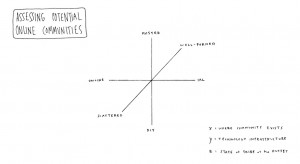
Writer Allison Levy worked alone. While she liked the freedom and flexibility of working from home, she sometimes missed having a community of coworkers, both for the practical purpose of brainstorming and the more social “water cooler” aspect. Levy did what many do in the internet age: she found a group of other writers online through a web forum. Over time, a group of approximately 20 writers, who all wrote for a similar audience, broke off from the larger forum and started a private invitation-only forum. While writers in general represent all genders, ages, and interests, it ended up being a collection of 20- and 30-something women who comprised the new forum — they all wrote fiction for children and young adults.At first, the writers’ forum was clearly a secondary group united by the members’ professions and work situations. As Levy explained, “On the internet, you can be present or absent as often as you want. No one is expecting you to show up.” It was a useful place to research information about different publishers, find out who had recently sold what, and track industry trends. But as time passed, Levy found it served a different purpose. Since the group shared other characteristics beyond their writing (such as age and gender), the online conversation naturally turned to matters such as childrearing, aging parents, health, and exercise. Levy found it was a sympathetic place to talk about any number of subjects, not just writing. Further, when people didn’t post for several days, others expressed concern, asking whether anyone had heard from the missing writers. It reached a point where most members would tell the group if they were travelling or needed to be offline for a while.
The group continued to share. One member on the site who was going through a difficult family illness wrote, “I don’t know where I’d be without you women. It is so great to have a place to vent that I know isn’t hurting anyone.” Others shared similar sentiments.
On the other hand, Zygmunt Bauman (2004) discusses the way electronically mediated groups like this online web forum tend to be frail communities, “easy to enter and easy to abandon.” They do not substitute for the more tangible and solid “we” feeling of face to face forms of togetherness, which require commitment and risk. Virtual communities “create only an illusion of intimacy and a pretense of community. They are not valid substitutes for ‘getting your knees under the table, seeing people’s faces, and having real conversation.'” They are a version of what Bauman calls cloakroom communities, places where one can hang one’s identity like a cloak for the duration of the “show”– i.e., one’s interest in the group’s theme and interactions — and then collect it again when it’s time to move on.
So is this online writers’ forum a primary group? Most of these people have never met each other. They live in Hawaii, Australia, Minnesota, and across the world. They may never meet. Levy wrote recently to the group, saying, “Most of my ‘real-life’ friends and even my husband don’t really get the writing thing. I don’t know what I’d do without you.” Despite the distance and the lack of physical contact, the group clearly fills an expressive need. How are our needs for primary group intimacy altered in the age of electronic media?

In-Groups and Out-Groups
One of the ways that groups can be powerful is through inclusion, and its inverse, exclusion. In-groups and out-groups are subcategories of primary and secondary groups that help identify this dynamic. Primary groups consist of both in-groups and out-groups, as do secondary groups. The feeling that one belongs in an elite or select group is a heady one, while the feeling of not being allowed in, or of being in competition with a group, can be motivating in a different way. Sociologist William Sumner (1840–1910) developed the concepts of in-group and out-group to explain this phenomenon (Sumner, 1906/1959). In short, an in-group is the group that an individual feels he or she belongs to, and believes it to be an integral part of who he or she is. An out-group, conversely, is a group someone doesn’t belong to; often there may be a feeling of disdain or competition in relation to an out-group. Sports teams, unions, and secret societies are examples of in-groups and out-groups; people may belong to, or be an outsider to, any of these.
While these affiliations can be neutral or even positive, such as the case of a team-sport competition, the concept of in-groups and out-groups can also explain some negative human behaviour, such as white supremacist movements like the Ku Klux Klan, or the bullying of gay or lesbian students. By defining others as “not like us” and inferior, in-groups can end up practicing ethnocentrism, racism, sexism, ageism, and heterosexism — manners of judging others negatively based on their culture, race, sex, age, or sexuality. Often, in-groups can form within a secondary group. For instance, a workplace can have cliques of people, from senior executives who play golf together, to engineers who write code together, to young singles who socialize after hours. While these in-groups might show favouritism and affinity for other in-group members, the overall organization may be unable or unwilling to acknowledge it. Therefore, it pays to be wary of the politics of in-groups, since members may exclude others as a form of gaining status within the group.
Making Connections: Social Policy and Debate
Bullying and Cyberbullying: How Technology Has Changed the Game

Most of us know that the old rhyme “sticks and stones may break my bones, but words will never hurt me” is inaccurate. Words can hurt, and never is that more apparent than in instances of bullying. Bullying has always existed, often reaching extreme levels of cruelty in children and young adults. People at these stages of life are especially vulnerable to others’ opinions of them, and they’re deeply invested in their peer groups. Today, technology has ushered in a new era of this dynamic. Cyberbullying is the use of interactive media by one person to torment another, and it is on the rise. Cyberbullying can mean sending threatening texts, harassing someone in a public forum (such as Facebook), hacking someone’s account and pretending to be him or her, posting embarrassing images online, and so on. A study by the Cyberbullying Research Center found that 20% of middle-school students admitted to “seriously thinking about committing suicide” as a result of online bullying (Hinduja and Patchin, 2010). Whereas bullying face-to-face requires willingness to interact with your victim, cyberbullying allows bullies to harass others from the privacy of their homes without witnessing the damage firsthand. This form of bullying is particularly dangerous because it’s widely accessible and therefore easier to accomplish.
Cyberbullying, and bullying in general, made international headlines in 2012 when a 15-year-old girl, Amanda Todd, in Port Coquitlam, B.C., committed suicide after years of bullying by her peers, and internet sexual exploitation. A month before her suicide, she posted a YouTube video in which she recounted her story. It began in grade 7 when she had been lured to reveal her breasts in a webcam photo. A year later, when she refused to give an anonymous male “a show,” the picture was circulated to her friends, family, and contacts on Facebook. Statistics Canada reported that 7% of internet users aged 18 and over have been cyberbullied, most commonly (73%) by receiving threatening or aggressive emails or text messages. Nine percent of adults who had a child at home aged 8 to 17 reported that at least one of their children had been cyberbullied. Two percent reported that their child had been lured or sexually solicited online (Perreault, 2011).
In the aftermath of Amanda Todd’s death, most provinces enacted strict guidelines and codes of conduct obliging schools to respond to cyberbullying and encouraging students to come forward to report victimization. In 2013, the federal government proposed Bill C-13 — the Protecting Canadians from Online Crime Act — which would make it illegal to share an intimate image of a person without that person’s consent. (Critics, however, note that the anti-cyberbullying provision in the bill is only a minor measure among many others that expand police powers to surveil all internet activity.) Will these measures change the behaviour of would-be cyberbullies? That remains to be seen. But hopefully communities can work to protect victims before they feel they must resort to extreme measures.
Reference Groups

A reference group is a group that people compare themselves to — it provides a standard of measurement. In Canadian society, peer groups are common reference groups. Children, teens, and adults pay attention to what their peers wear, what music they like, what they do with their free time — and they compare themselves to what they see. Most people have more than one reference group, so a middle-school boy might look not only at his classmates but also at his older brother’s friends and see a different set of norms. And he might observe the antics of his favourite athletes for yet another set of behaviours.
Some other examples of reference groups can be one’s church, synagogue, or mosque; one’s cultural centre, workplace, or family gathering; and even one’s parents. Often, reference groups convey competing messages. For instance, on television and in movies, young adults often have wonderful apartments, cars, and lively social lives despite not holding a job. In music videos, young women might dance and sing in a sexually aggressive way that suggests experience beyond their years. At all ages, we use reference groups to help guide our behaviour and show us social norms. So how important is it to surround yourself with positive reference groups? You may never meet or know a particular reference group, but it may still impact and influence how you act. Identifying reference groups can help you understand the source of the social identities you aspire to or want to distance yourself from.
Making Connections: Sociology in the Real World
University: A World of In-Groups, Out-Groups, and Reference Groups

For a student entering university, the sociological study of groups takes on an immediate and practical meaning. After all, when we arrive someplace new, most of us look around to see how well we fit in, or stand out, in the ways we want. This is a natural response to a reference group, and on a large campus, there can be many competing groups. Say you are a strong athlete who wants to play intramural sports, but your favourite musicians are a local punk band. You may find yourself engaged with two very different reference groups.
These reference groups can also become your in-groups or out-groups. For instance, different groups on campus might solicit you to join. Are there student-union-sponsored clubs at your school? Is there a Club Day when the student clubs set up tables and displays? The spelunking club, the Aikido club, the square dance club, the Conservative Party club, the Green Party club, the chess club, the jazz club, the kayak club, the tightrope walkers club, the peace and disarmament club, the French club, the young women in business club — enumerable clubs will try to convince students to join them.
While most clubs are pretty casual, along with a shared interest comes many subtle cues about what sorts of people will fit in and what sorts will not. While most campus groups refrain from insulting competing groups, there is a definite sense of an in-group versus an out-group. “Them?” a member might say, “They’re all right, but they are pretty geeky.” Or, “Only really straight people join that group.” This immediate categorization into in-groups and out-groups means that students must choose carefully, since whatever group they associate with will not just define their friends — it may also define types of people with whom they will not associate.
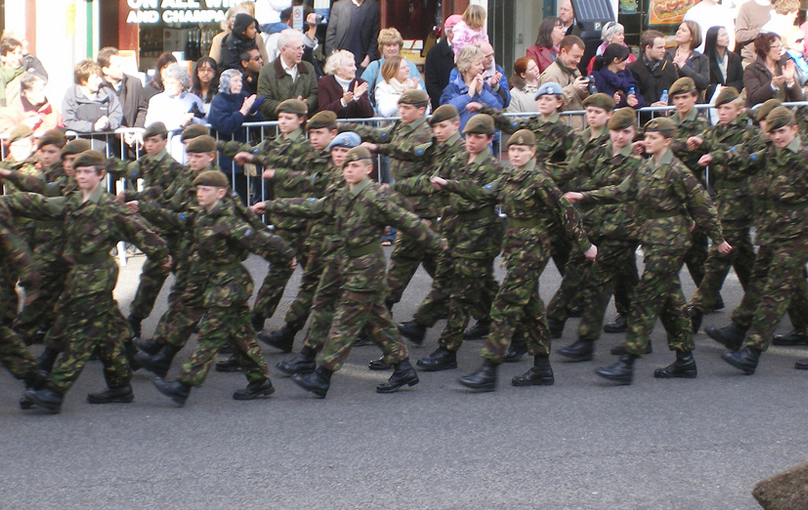
Large Groups
It is difficult to define exactly when a small group becomes a large group. One step might be when there are too many people to join in a simultaneous discussion. Another might be when a group joins with other groups as part of a movement that unites them. These larger groups may share a geographic space, such as Occupy Montreal or the People’s Assembly of Victoria, or they might be spread out around the globe. The larger the group, the more attention it can garner, and the more pressure members can put toward whatever goal they wish to achieve. At the same time, the larger the group becomes, the more the risk grows for division and lack of cohesion.
One can think of three main social forms by which the content or activity of a group might be organized to prevent division and lack of cohesion: domination, cooperation, and competition. No matter what the organization is — a hockey franchise, a workplace, or a social movement — the choice of one form of organization over the others has consequences in terms of the loyalty of members and the efficiency and effectiveness of the group in achieving its goals. In the form of domination, power is concentrated in the hands of leaders while the power of subordinates is severely restricted or constrained. In extreme versions of domination, like slavery, loyalty and efficiency are low because fear of coercion is the only motivation. In the form of cooperation on the other hand, power is distributed relatively equally and loyalty and efficiency are high because the group is based on mutual trust and high levels of commitment. In the form of competition, power is distributed unequally but there is latitude for movement based on the outcome of competition for prestige or money. Loyalty and efficiency are relatively high but only as long as the pay-offs are high.
In a Star Trek episode from the 1960s, “Patterns of Force,” the crew of the Enterprise discover that a rogue historian has gone against the Prime Directive and reorganized a planet’s culture on the basis of Nazi Germany. In order to address the planet’s condition of chaos, he appealed to the “efficiency” of Nazism only to unleash a systematic persecution of one native group by the other. The ensuing drama in the episode reveals that the historian mistook domination for efficiency. As Spock puts it at the end of the episode, how could such a noted historian make the logical error of emulating the Nazis? Captain Kirk responds by saying that the failure was in putting so much power in the hands of a dictator, to which Dr. McCoy adds that power corrupts. In fact, as historians point out, Nazi Germany was startlingly inefficient, if only because all major decisions were filtered through Hitler himself who was notoriously unpredictable, hard to get the attention of, and lacked any form of personal routine (Kershaw, 1998). The irony of the Star Trek episode is of course that the Starship Enterprise itself is organized on the formal basis of domination. It is only the leadership style that differs.
Group Leadership
Often, larger groups require some kind of leadership. In small, primary groups, leadership tends to be informal. After all, most families don’t take a vote on who will rule the group, nor do most groups of friends. This is not to say that de facto leaders do not emerge, but formal leadership is rare.
In a series of small group studies at Harvard in the 1950s, Robert Bales (1970) studied the group processes that emerged around solving problems. No matter what the specific tasks were, he discovered that in all the successful groups — i.e., in the groups that were able to see their tasks through to the end without breaking up — three types of informal leader emerged: a task leader, an emotional leader, and a joker. The task leader was the person who stepped up to organize the group to solve the problem by setting goals and distributing tasks. The emotional leader was the person who helped the group resolve disagreements and frustrations when strong feelings emerged. The joker made fun and fooled around but also had the knack for releasing group tension by making jokes. These leadership roles emerged spontaneously in the small groups without planning or awareness that they were needed. They appear to simply be properties of task-oriented, face-to-face groups.
Making Connections: Case Study
Women Leaders and the Glass Ceiling

Elizabeth May, leader of the Green Party, was voted best parliamentarian of the year in 2012 and hardest-working parliamentarian in 2013. She stands out among the party leaders as both the only female and the only leader focused on changing leadership style. Among her proposals for changing leadership are reducing centralization and hierarchical control of party leaders, allowing MPs to vote freely, decreasing narrow political partisanship, engaging in cross-partisan collaboration, and restoring respect and decorum to House of Commons debates. The focus on a collaborative, non-conflictual approach to politics is a component of her expressive leadership style, typically associated with female leadership qualities.
However, as a female leader Elizabeth May is obliged to walk a tight line that does not generally apply to male politicians. According to some political analysts, women candidates face a paradox: they must be as tough as their male opponents on issues, such as foreign or economic policy, or risk appearing weak (Weeks, 2011). However, the stereotypical expectation of women as expressive leaders is still prevalent. Consider that Hillary Clinton’s popularity surged in her 2008 campaign for the U.S. Democratic presidential nomination after she cried on the campaign trail. It was enough for the New York Times to publish an editorial, “Can Hillary Cry Her Way Back to the White House?” (Dowd, 2008). Harsh, but her approval ratings soared afterwards. In fact, many compared it to how politically likable she was in the aftermath of President Clinton’s Monica Lewinsky scandal.
In the case of Elizabeth May, many pundits believed that she won the 2008 election leaders debate by being firm in her criticism of government policy, and being both intelligent and clear in her statements. (Notably, she was prevented from participating in the 2011 election leaders’ debate — perhaps for the same reasons.) She was able to articulate the rationale behind a national carbon tax to reduce greenhouse gases, whereas then Liberal leader Stéphane Dion seemed to struggle to explain his “Green Shift” policy. “We tax the pollution, and we take the taxes off families,” she said (Foot, 2008). The idea of winning debates and defeating opponents in a hostile environment is regarded as a masculine virtue. At the same time, May is subject to criticisms that have to do with her femininity, in a way that male politicians are not subject to similar criticisms about their masculinity. Media tycoon Conrad Black called her “a frumpy, noisy, ill-favoured, half-deranged windbag” to which, May quipped, “He’s right on one point: I certainly am frumpy. I don’t have anything like Barbara Amiel’s [Black’s well-known journalist wife] sense of style. But on the whole, I figure being attacked by Conrad Black is in its own way an accolade in this country” (Allemang, 2009).
Despite the cleverness of May’s retort, the pitfalls of her situation as a female leader reflect broader issues women confront in assuming leadership roles. Whereas women have been closing the gap with men in terms of workforce participation and educational attainment over the last decades, their average income has remained at approximately 70% of men’s, and their representation in leadership roles (legislators, senior officials, and managers) has remained at 50% of men’s (i.e., men are twice as likely as women to attain leadership roles in these professions than women). In terms of the representation of women in Parliament, cabinet, and political leadership, the figures are much lower at 15% (despite the fact that several provinces have had women as premiers) (McInturff, 2013).
One concept for describing the situation facing women’s access to leadership positions is the glass ceiling. Whereas most of the explicit barriers to women’s achievement have been removed through legislative action, norms of gender equality, and affirmative action policies, women often get stuck at the level of middle management. There is a glass ceiling or invisible barrier that prevents them from achieving positions of leadership (Tannen, 1994). This is also reflected in gender inequality in income over time. Early in their careers men’s and women’s incomes are more or less equal but at mid-career, the gap increases significantly (McInturff, 2013).
Tannen argues that this barrier exists in part because of the different work styles of men and women, in particular conversational-style differences. Whereas men are very aggressive in their conversational style and their self-promotion, women are typically consensus builders who seek to avoid appearing bossy and arrogant. As a linguistic strategy of office politics, it is common for men to say “I” and claim personal credit in situations where women would be more likely to use “we” and emphasize teamwork. As it is men who are often in the positions to make promotion decisions, they interpret women’s style of communication “as showing indecisiveness, inability to assume authority, and even incompetence” (Tannen, 1994).
Because of the inherent qualities in women’s expressive leadership, which in many cases is more effective, their skills, merits, and achievements go unrecognized. In terms of political leadership, one political analyst said bluntly, “women don’t succeed in politics — or other professions — unless they act like men. The standard for running for national office remains distinctly male” (Weeks, 2011).
In secondary groups, leadership is usually more overt. There are often clearly outlined roles and responsibilities, with a chain of command to follow. Some secondary groups, like the army, have highly structured and clearly understood chains of command, and many lives depend on those. After all, how well could soldiers function in a battle if they had no idea whom to listen to or if different people were calling out orders? Other secondary groups, like a workplace or a classroom, also have formal leaders, but the styles and functions of leadership can vary significantly.
Leadership function refers to the main focus or goal of the leader. An instrumental leader is one who is goal-oriented and largely concerned with accomplishing set tasks. An army general or a Fortune 500 CEO would be an instrumental leader. In contrast, expressive leaders are more concerned with promoting emotional strength and health, and ensuring that people feel supported. Social and religious leaders — rabbis, priests, imams, and directors of youth homes and social service programs — are often perceived as expressive leaders. There is a longstanding stereotype that men are more instrumental leaders and women are more expressive leaders. Although gender roles have changed, even today, many women and men who exhibit the opposite-gender manner can be seen as deviants and can encounter resistance. Former U.S. Secretary of State and presidential candidate Hillary Clinton provides an example of how society reacts to a high-profile woman who is an instrumental leader. Despite the stereotype, Boatwright and Forrest (2000) have found that both men and women prefer leaders who use a combination of expressive and instrumental leadership.

In addition to these leadership functions, there are three different leadership styles. Democratic leaders encourage group participation in all decision making. The group is essentially cooperative. These leaders work hard to build consensus before choosing a course of action and moving forward. This type of leader is particularly common, for example, in a club where the members vote on which activities or projects to pursue. These leaders can be well-liked, but there is often a challenge that the work will proceed slowly since consensus building is time-consuming. A further risk is that group members might pick sides and entrench themselves into opposing factions rather than reaching a solution.
In contrast, a laissez-faire leader (French for “leave it alone”) is hands-off, allowing group members to self-manage and make their own decisions. An example of this kind of leader might be an art teacher who opens the art cupboard, leaves materials on the shelves, and tells students to help themselves and make some art. While this style can work well with highly motivated and mature participants who have clear goals and guidelines, it risks group dissolution and a lack of progress.
As the name suggests, authoritarian leaders issue orders and assigns tasks. These leaders are clear instrumental leaders with a strong focus on meeting goals. Often, entrepreneurs fall into this mould, like Facebook founder Mark Zuckerberg. Not surprisingly, this type of leader risks alienating the workers. There are times, however, when this style of leadership can be required. In different circumstances, each of these leadership styles can be effective and successful. Consider what leadership style you prefer. Why? Do you like the same style in different areas of your life, such as a classroom, a workplace, and a sports team?
Conformity
We all like to fit in to some degree. Likewise, when we want to stand out, we want to choose how we stand out and for what reasons. For example, a woman who loves cutting-edge fashion and wants to dress in thought-provoking new styles likely wants to be noticed within a framework of high fashion. She would not want people to think she was too poor to find proper clothes. Conformity is the extent to which an individual complies with group norms or expectations. As you might recall, we use reference groups to assess and understand how we should act, dress, and behave. Not surprisingly, young people are particularly aware of who conforms and who does not. A high school boy whose mother makes him wear ironed, button-down shirts might protest that he will look stupid — that everyone else wears T-shirts. Another high school boy might like wearing those shirts as a way of standing out. Recall Georg Simmel’s analysis of the contradictory dynamics of fashion: it represents both the need to conform and the need to stand out. How much do you enjoy being noticed? Do you consciously prefer to conform to group norms so as not to be singled out? Are there people in your class or peer group who immediately come to mind when you think about those who do, and do not, want to conform?
A number of famous experiments in the 1950s, 60s, and 70s tested the propensity of individuals to conform to authority. We have already examined the Stanford Prison experiment in Chapter 2. Within days of beginning the simulated prison experiment, the random sample of university students proved themselves capable of conforming to the roles of prison guards and prisoners to an extreme degree, even though the conditions were highly artificial (Haney, Banks, and Zimbardo, 1973).
Stanley Milgram conducted experiments in the 1960s to determine how structures of authority rendered individuals obedient (Milgram, 1963). This was shortly after the Adolf Eichmann war crime trial in which Eichmann claimed that he was just a bureaucrat following orders when he helped to organize the Holocaust. Milgram had experimental subjects administer, what they were led to believe were, electric shocks to a subject when the subject gave a wrong answer to a question. Each time a wrong answer was given, the experimental subject was told to increase the intensity of the shock. The experiment was supposed to be testing the relationship between punishment and learning, but the subject receiving the shocks was an actor. As the experimental subjects increased the amount of voltage, the actor began to show distress, eventually begging to be released. When the subjects became reluctant to administer more shocks, Milgram (wearing a white lab coat to underline his authority as a scientist) assured them that the actor would be fine and that the results of the experiment would be compromised if the subject did not continue. Seventy-one percent of the experimental subjects were willing to continue administering shocks, even beyond 285 volts, despite the actor crying out in pain, and the voltage dial labelled with warnings like “Danger: Severe shock.”
Making Connections: Sociological Research
Groupthink: Conforming to Expectations

Psychologist Solomon Asch (1907–1996) conducted experiments that illustrated how great the pressure to conform is, specifically within a small group (1956). In 1951, he sat a small group of eight people around a table. Only one of the people sitting there was the true experimental subject; the rest were actors or associates of the experimenter. However, the subject was led to believe that the others were all, like him, people brought in for an experiment in visual judgments. The group was shown two cards, the first card with a single vertical line, and the second card with three vertical lines differing in length. The experimenter polled the group, asking each participant, one at a time, which line on the second card matched up with the line on the first card.
However, this was not really a test of visual judgment. Rather, it was Asch’s study on the pressures of conformity. He was curious to see what the effect of multiple wrong answers would be on the subject, who presumably was able to tell which lines matched. In order to test this, Asch had each planted respondent answer in a specific way. The subject was seated in such a way that he had to hear almost everyone else’s answers before it was his turn. Sometimes the non-subject members would unanimously choose an answer that was clearly wrong.
So what was the conclusion? Asch found that 37 out of 50 test subjects responded with an “obviously erroneous” answer at least once. When faced by a unanimous wrong answer from the rest of the group, the subject conformed to a mean of four of the staged answers. Asch revised the study and repeated it, wherein the subject still heard the staged wrong answers, but was allowed to write down his answer rather than speak it aloud. In this version, the number of examples of conformity — giving an incorrect answer so as not to contradict the group — fell by two-thirds. He also found that group size had an impact on how much pressure the subject felt to conform.
The results showed that speaking up when only one other person gave an erroneous answer was far more common than when five or six people defended the incorrect position. Finally, Asch discovered that people were far more likely to give the correct answer in the face of near-unanimous consent if they had a single ally. If even one person in the group also dissented, the subject conformed only a quarter as often. Clearly, it was easier to be a minority of two than a minority of one.
Asch concluded that there are two main causes for conformity: people want to be liked by the group or they believe the group is better informed than they are. He found his study results disturbing. To him, they revealed that intelligent, well-educated people would, with very little coaxing, go along with an untruth. This phenomenon is known as groupthink, the tendency to conform to the attitudes and beliefs of the group despite individual misgivings. He believed this result highlighted real problems with the education system and values in our society (Asch, 1956).
What would you do in Asch’s experiment? Would you speak up? What would help you speak up and what would discourage you?
6.3. Networks
Dyads, Triads, and Social Networks
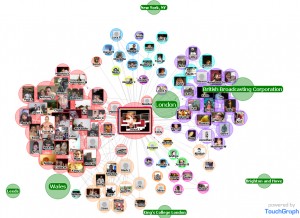
A small group is typically one where the collection of people is small enough that all members of the group know each other and share simultaneous interaction, such as a nuclear family, a dyad, or a triad. Georg Simmel wrote extensively about the difference between a dyad, or two-member group, and a triad, a three-member group (Simmel, 1908/1950). No matter what the content of the groups is — business, friendship, family, teamwork, etc. — the dynamic or formal qualities of the groups differ simply by virtue of the number of individuals involved. The forms of sociation available to individuals differ significantly for dyads and triads, no matter the specific reason (content) for the sociation (e.g., friendship, love, business, leisure, etc.). The social dynamic inheres in the number of individuals, no matter who they are or their specific interests. This insight forms the basis of the analysis of networks, which are another of the major meso-level social phenomena examined in sociology.
In a dyad, if one person withdraws, the group can no longer exist. Examples include a divorce, which effectively ends the “group” of the married couple, or two best friends never speaking again. Neither of the two members can hide what he or she has done behind the group, nor hold the group responsible for what he or she has failed to do.
In a triad, however, the dynamic is quite different. If one person withdraws, the group lives on. A triad has a different set of relationships. If there are three in the group, two-against-one dynamics can develop and the potential exists for a majority opinion on any issue. At the same time, the relationships in a triad cannot be as close as in a dyad because a third person always intrudes. Where a group of two is both closer and more unstable than a group of three, because it rests on the immediate, ongoing reciprocity of the two members, a group of three is able to attain a sense of super-personal life, independent of the members.
The difference between a dyad and a triad is an example of network analysis. A social network is a collection of people who exchange resources (emotional, informational, financial, etc.) tied together by a specific configuration of connections. They can be characterized by the number of people involved, as in the dyad and triad, but also in terms of their structures (who is connected to whom) and functions (what resources flow across ties). The particular configurations of the connections determine how networks are able to do more things and different things than individuals acting on their own could. Networks have this effect, regardless of the content of the connections or persons involved.
For example, if one person phones 50 people one after the other to see who could come out to play ball hockey on Wednesday night, it would take a long time to work through the phone list. The structure of the network would be one in which the telephone caller has an individual connection with each of the 50 players, but the players themselves do not necessarily have any connections with each other. There is only one node in the network. On the other hand, if the telephone caller phones five key (or nodal) individuals, who would then call five individuals, and so on, then the telephone calling would be accomplished much more quickly. A telephone tree like this has a different network structure than the single telephone caller model does and can therefore accomplish the task much more efficiently and quickly. Of course the responsibility is also shared so there are more opportunities for the communication network to break down.
Network analysis is interesting because much of social life can be understood as operating outside of either formal organizations or traditional group structures. Social media like Twitter or Facebook connect people through networks. One’s posts are seen by friends, but also by friends of friends. The revolution in Tunisia in 2010–2011 was aided by social media networks, which were able to disseminate an accurate, or alternate, account of the events as they unfolded, even while the official media characterized the unrest as vandalism and terrorism (Zuckerman, 2011). On the other hand, military counterinsurgency strategies trace cell phone connections to model the networks of insurgents in asymmetrical or guerilla warfare. Increased densities of network connections indicate the centrality of key insurgents and the ability of insurgents to mount coordinated attacks (Department of the Army, 2006). The amorphous nature of global capital and the formation of a global capitalist class consciousness can also be analyzed by mapping interlocking directorates; namely, the way institutionalized social networks are established between banks and corporations in different parts of the world through shared board members. Network analysis reveals the break up of national-based corporate elite networks, and the establishment of a unified and coordinated transatlantic capitalist class (Carroll, 2010).
Christakis and Fowler (2009) argue that social networks are influential in a wide range of social aspects of life, including political opinions, weight gain, and happiness. They develop Stanley Milgram’s claim that there is only six degrees of separation between any two individuals on Earth by adding that in a network, it can be demonstrated that there are also three degrees of influence. That is, one is not only influenced by one’s immediate friends and social contacts, but by their friends, and their friends’ friends. For example, an individual’s chance of becoming obese increases 57% if a friend becomes obese; it increases by 20% if it is a friend’s friend who becomes obese; and it increases 10% if it is a friend’s friend’s friend who becomes obese. Beyond the third degree of separation, there is no measurable influence.
6.4. Formal Organizations
A complaint of modern life is that society is dominated by large and impersonal secondary organizations. From schools to businesses to health care to government, these organizations are referred to as formal organizations. A formal organization is a large secondary group deliberately organized to achieve its goals efficiently. Typically, formal organizations are highly bureaucratized. The term bureaucracy refers to what Max Weber termed “an ideal type” of formal organization (1922/1946). In its sociological usage, “ideal” does not mean “best”; it refers to a general model that describes a collection of characteristics, or a type that could describe most examples of the item under discussion. For example, if your professor were to tell the class to picture a car in their minds, most students will picture a car that shares a set of characteristics: four wheels, a windshield, and so on. Everyone’s car will be somewhat different, however. Some might picture a two-door sports car while others might picture an SUV. It is possible for a car to have three wheels instead of four. However, the general idea of the car that everyone shares is the ideal type. Bureaucracies are similar. While each bureaucracy has its own idiosyncratic features, the way each is deliberately organized to achieve its goals efficiently shares a certain consistency. We will discuss bureaucracies as an ideal type of organization.
Types of Formal Organizations

Sociologist Amitai Etzioni (1975) posited that formal organizations fall into three categories. Normative organizations, also called voluntary organizations, are based on shared interests. As the name suggests, joining them is voluntary and typically people join because they find membership rewarding in an intangible way. Compliance to the group is maintained through moral control. The Audubon Society or a ski club are examples of normative organizations. Coercive organizations are groups that one must be coerced, or pushed, to join. These may include prison, the military, or a rehabilitation centre. Compliance is maintained through force and coercion. Goffman (1961) states that most coercive organizations are total institutions. A total institution is one in which inmates live a controlled life apart from the rest of society, and in which total resocialization takes place. The third type are utilitarian organizations, which, as the name suggests, are joined because of the need for a specific material reward. High school or a workplace would fall into this category — one joined in pursuit of a diploma, the other in order to make money. Compliance is maintained through remuneration and rewards.
| Normative or Voluntary | Coercive | Utilitarian | |
|---|---|---|---|
| Benefit of Membership | Non-material benefit | Corrective or disciplinary benefit | Material benefit |
| Type of Membership | Volunteer basis | Obligatory basis | Contractual basis |
| Feeling of Connectedness | Shared affinity | Coerced affinity | Pragmatic affinity |
Bureaucracies
Bureaucracies can be described as an ideal type of formal organization. This does not mean that they are ideal in an ethical sense but that the logic of their components can be laid out according to an idealized model. Not all formal organizations or bureaucracies will necessarily conform to the ideal type. Pioneer sociologist Max Weber (1922/1946) popularly characterized bureaucracy through an ideal type description as having a hierarchy of authority, a clear division of labour, explicit rules, and impersonality. Bureaucracies were the basic form of rational efficient organization, yet people often complain about bureaucracies, declaring them slow, rule-bound, difficult to navigate, and unfriendly. Let us take a look at terms that define bureaucracy as an ideal type of formal organization to understand what they mean.
Hierarchy of authority refers to the aspect of bureaucracy that places one individual or office in charge of another, who in turn must answer to her own superiors. For example, if you are an employee at Walmart, your shift manager assigns you tasks. Your shift manager answers to the store manager, who must answer to the regional manager, and so on in a chain of command up to the CEO, who must answer to the board members, who in turn answer to the stockholders. There is a clear chain of authority that enables each person to know who he or she is answerable to or responsible for, which is necessary for the organization to make and comply with decisions.
A clear division of labour refers to the fact that within a bureaucracy, each individual has a specialized task to perform. For example, psychology professors teach psychology, but they do not attempt to provide students with financial aid forms. In this case, it is a clear and commonsensical division. But what about in a restaurant where food is backed up in the kitchen and a hostess is standing nearby texting on her phone? Her job is to seat customers, not to deliver food. Is this a smart division of labour?
The existence of explicit rules refers to the way in which rules are outlined, written down, and standardized. There is a continuous organization of official functions bound by rules. For example, at your college or university, student guidelines are contained within the student handbook. As technology changes and campuses encounter new concerns like cyberbullying, identity theft, and other issues, organizations are scrambling to ensure their explicit rules cover these emerging topics.
Bureaucracies are also characterized by impersonality, which takes personal feelings out of professional situations. Each office or position exists independently of its incumbent, and clients and workers receive equal treatment. This characteristic grew, to some extent, out of a desire to eliminate the potential for nepotism, backroom deals, and other types of “irrational” favouritism, simultaneously protecting customers and others served by the organization. Impersonality is an attempt by large formal organizations to protect their members. However, the result is often that personal experience is disregarded. For example, you may be late for work because your car broke down, but the manager at Pizza Hut doesn’t care why you are late, only that you are late.
Finally, bureaucracies are, in theory at least, meritocracies, meaning that hiring and promotion are based on proven and documented skills, rather than on nepotism or random choice. In order to get into graduate school, you need to have an impressive transcript. In order to become a lawyer and represent clients, you must graduate from law school and pass the provincial bar exam. Of course, there is a popular image of bureaucracies that they reward conformity and sycophancy rather than skill or merit. How well do you think established meritocracies identify talent? Wealthy families hire tutors, interview coaches, test-prep services, and consultants to help their children get into the best schools. This starts as early as kindergarten in New York City, where competition for the most highly regarded schools is especially fierce. Are these schools, many of which have copious scholarship funds that are intended to make the school more democratic, really offering all applicants a fair shake?
Max Weber (1922/1946) summarizes:
Precision, speed, unambiguity, knowledge of the files, continuity, discretion, unity, strict subordination, reduction of friction and of material and personal costs — these are raised to the optimum point in the strictly bureaucratic administration … Bureaucratization offers above all the optimum possibility for carrying through the principle of specializing administrative functions according to purely objective considerations . . . The ‘objective’ discharge of business primarily means a discharge of business according to calculable rules and ‘without regard for persons.’
There are several positive aspects of bureaucracies. They are intended to improve efficiency, ensure equal opportunities, and increase efficiency. There are times when rigid hierarchies are needed. However, there is also a clear component of irrationality within the rational organization of bureaucracies. Firstly, bureaucracies create conditions of bureaucratic alienation in which workers cannot find meaning in the repetitive, standardized nature of the tasks they are obliged to perform. As Max Weber put it, the “individual bureaucrat cannot squirm out of the apparatus in which he is harnessed… He is only a single cog in an ever‐moving mechanism which prescribes to him an essentially fixed route of march” (1922/1946). Secondly, bureaucracies can lead to bureaucratic inefficiency and ritualism (red tape). They can focus on rules and regulations to the point of undermining the organization’s goals and purpose. Thirdly, bureaucracies have a tendency toward inertia. You may have heard the expression “trying to turn a tanker around mid-ocean,” which refers to the difficulties of changing direction with something large and set in its ways. Inertia means bureaucracies focus on perpetuating themselves rather than effectively accomplishing or re-evaluating the tasks they were designed to achieve. Finally, as Robert Michels (1911/1949) suggested, bureaucracies are characterized by the iron law of oligarchy in which the organization is ruled by a few elites. The organization serves to promote the self-interest of oligarchs and insulate them from the needs of the public or clients.
Remember that many of our bureaucracies grew large at the same time that our school model was developed — during the Industrial Revolution. Young workers were trained and organizations were built for mass production, assembly-line work, and factory jobs. In these scenarios, a clear chain of command was critical. Now, in the information age, this kind of rigid training and adherence to protocol can actually decrease both productivity and efficiency. Today’s workplace requires a faster pace, more problem solving, and a flexible approach to work. Smaller organizations are often more innovative and competitive because they have flatter hierarchies and more democratic decision making, which invites more communication, greater networking, and increased individual participation of members. Too much adherence to explicit rules and a division of labour can leave an organization behind. Unfortunately, once established, bureaucracies can take on a life of their own. As Max Weber said, “Once it is established, bureaucracy is among those social structures which are the hardest to destroy” (1922/1946).

The McDonaldization of Society
The McDonaldization of society (Ritzer, 1994) refers to the increasing presence of the fast-food business model in common social institutions. This business model includes efficiency (the division of labour), predictability, calculability, and control (monitoring). For example, in your average chain grocery store, people at the cash register check out customers while stockers keep the shelves full of goods, and deli workers slice meats and cheese to order (efficiency). Whenever you enter a store within that grocery chain, you receive the same type of goods, see the same store organization, and find the same brands at the same prices (predictability). You will find that goods are sold by the kilogram, so that you can weigh your fruit and vegetable purchases rather than simply guessing at the price for that bag of onions, while the employees use a time card to calculate their hours and receive overtime pay (calculability). Finally, you will notice that all store employees are wearing a uniform (and usually a name tag) so that they can be easily identified. There are security cameras to monitor the store, and some parts of the store, such as the stockroom, are generally considered off-limits to customers (control).
While McDonaldization has resulted in improved profits and an increased availability of various goods and services to more people worldwide, it has also reduced the variety of goods available in the marketplace while rendering available products uniform, generic, and bland. Think of the difference between a mass-produced shoe and one made by a local cobbler, between a chicken from a family-owned farm versus a corporate grower, or a cup of coffee from the local roaster instead of one from a coffee-shop chain. Ritzer also notes that the rational systems, as efficient as they are, are irrational in that they become more important than the people working within them, or the clients being served by them. “Most specifically, irrationality means that rational systems are unreasonable systems. By that I mean that they deny the basic humanity, the human reason, of the people who work within or are served by them.” (Ritzer, 1994)
Making Connections: Sociological Research
Secrets of the McJob
We often talk about bureaucracies disparagingly, and no organizations have taken more heat than fast-food restaurants. The book and movie Fast Food Nation: The Dark Side of the All-American Meal by Eric Schossler (2001) paints an ugly picture of what goes in, what goes on, and what comes out of fast-food chains. From their environmental impact to their role in the U.S. obesity epidemic, fast-food chains are connected to numerous societal ills. Furthermore, working at a fast-food restaurant is often disparaged, and even referred to dismissively, as a McJob rather than a real job.
But business school professor Jerry Newman (2007) went undercover and worked behind the counter at seven fast-food restaurants to discover what really goes on there. His book, My Secret Life on the McJob, documents his experience. Newman found, unlike Schossler, that these restaurants have much good alongside the bad. Specifically, he asserted that the employees were honest and hard-working, the management was often impressive, and the jobs required a lot more skill and effort than most people imagined. In the book, Newman cites a pharmaceutical executive who states that a fast-food service job on an applicant’s résumé is a plus because it indicates the employee is reliable and can handle pressure.
So what do you think? Are these McJobs and the organizations that offer them still serving a role in the economy and people’s careers? Or are they dead-end jobs that typify all that is negative about large bureaucracies? Have you ever worked in one? Would you?
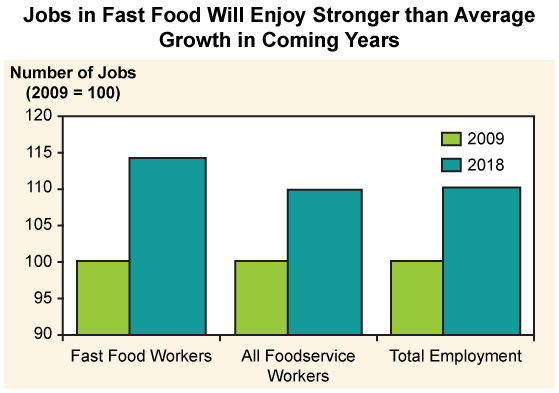
Summary
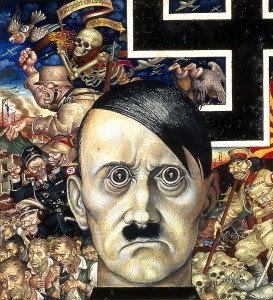
We end this chapter with a sociological analysis of the Holocaust to indicate the significance of some of the sociological dynamics of group behaviour. In sociology the group is always more than the sum of its parts. We have examined this with regard to how individuals change their behaviour when they are around others under various circumstances. In chapter 1 we noted how being in a crowd affected people very differently during the exuberance of the 2010 Vancouver Olympics and the riots of the 2011 Stanley Cup final. In this chapter we have seen how being a member of a social group influences people to conform or to choose in-group and out-group attachments. Depending on where one is located in a social network, individuals are enabled, to a lesser or greater degree, to share and receive resources of various sorts from friends, friends of friends, and friends of friends of friends, in ways which are also deeply influential. Formal organizations structure the relationships between individuals to be able to achieve organizational goals that individuals could not achieve on their own. How does the insight that the group is more than the sum of the parts help us to understand how the Holocaust was possible?
The Holocaust (literally “whole burnt”) refers to the the systematic program of extermination of European Jews and Gypsies (Roma) by Nazis between 1941 and 1945. During this period, it is estimated that 6,000,000 Jews and Gypsies were killed by the Nazis. How was it possible? It is difficult to imagine how this event could merely be the product of isolated individuals entering into interaction. It needs to be understood at the level of group behaviour.
Clearly, a significant minority of the population of Germany in the 1930s were anti-Semitic, but even among these individuals the concept of the Final Solution would have been unthinkable. Often, the explanation that has been put forward is that the Nazi era in 20th century Germany was a temporary aberration, a period of mass irrationality and social breakdown; an imposition of racism, hatred, and violence on the population by a megalomaniacal madman — Adolf Hitler — devoted to world domination. This explanation has an element of truth in that the combination of war reparations imposed on Germany after the First World War, the hyper-inflation of the 1920s, and the onset of a global capitalist crisis in the 1930s (the Great Depression) created conditions of instability and widespread desperation. Desperate people do not think clearly.
However, the sociological analysis of the rise of the Nazis and the implementation of the Holocaust is far more discomforting. The Nazis were democratically elected into power not once but twice (in 1932 and 1933); the suspension of the Weimar constitution and the institution of emergency rule were enacted through legal, constitutional means; the imposition of totalitarian rule and the internment of Jews, Gypsies, homosexuals, the disabled, and political opponents were enabled by the voluntary contributions of ordinary citizens; and perhaps most perplexingly, all of this was accomplished in one of the most modern, cultured, technologically advanced, and rational societies of Europe. Explanations of the behaviour of the perpetrators that relies on the idea that they were sadists, criminals, or madmen have been discredited for lack of evidence. While there were clearly a few individuals in the camps known for their sadistic cruelty, “by conventional clinical criteria no more than 10 per cent of the SS could be considered ‘abnormal'” (Kren and Rappoport, quoted in Bauman, 1989).
As Zygmunt Bauman (1989) has argued, the Holocaust could not have occurred without the existence of modern, rational forms of social organization:
The Holocaust was not an irrational outflow of the not-yet-fully-eradicated residues of pre-modern barbarity. It was a legitimate resident in the house of modernity; indeed, one who would not be at home in any other house (Bauman, 1989).
Bauman argues in particular that it was the rational, efficient organization of the Nazi bureaucracy which, once the problem of a Judenfrei Germany was posed by Hitler — a Germany “free” of Jews — enabled a series of solutions to be examined and rejected before the Final Solution was settled on. Bureaucracy also provided the three conditions which made overcoming individual emotional and moral aversion to the mass killing possible. Firstly, the violence was authorized according to correct bureaucratic procedures and hierarchical channels of command. Secondly, the violence was routinized by the rule-bound practices and clear division of labour of bureaucratic organization. Thirdly, the victims of the violence were dehumanized through, not only ideological propaganda and media spin, but also the impersonality inherent in bureaucracy (Bauman, 1989).
The point is that the Holocaust was the product of the same ordinary sociological phenomena that operate in society today, including the formation of in-groups and out-groups, conformity to structures of authority, groupthink, and the ‘rational’ structure of bureaucratic organizational forms. Therefore, an answer to the question about how the Holocaust was possible must begin with a study of Simmel’s forms of collective behaviour. Why do individuals conform to the will of collectivities even when this means overcoming strong personal moral convictions or rational thinking? An answer to this problem is difficult to get at if we begin simply from a micro-level perspective of interpersonal interactions. We need to examine the properties of groups at meso- and macro-levels to understand how the effect of the whole is more than the sum of the individual parts.
Key Terms
aggregate: A collection of people who exist in the same place at the same time, but who don’t interact or share a sense of identity.
authoritarian leader: A leader who issues orders and assigns tasks.
bureaucracy: A formal organization characterized by a hierarchy of authority, a clear division of labour, explicit rules, and impersonality.
category: People who share similar characteristics but who are not connected in any way.
clear division of labour: The structuring of work in a bureaucracy such that each individual has a specialized task to perform.
coercive organization: Organization that people do not voluntarily join, such as prison or a mental hospital.
conformity: The extent to which an individual complies with group or societal norms.
contents: The specific drives, needs, purposes, or interests of individuals that motivate them to interact with others.
core discussion group: The group of close, personal contacts with whom one confides on personal matters and with whom one chooses to spend free time.
democratic leader: A leader who encourages group participation and consensus-building before acting.
dyad: A two-member group.
explicit rules: The types of rules in a bureaucracy; rules that are outlined, recorded, and standardized.
expressive function: A group function that serves an emotional need.
expressive leader: A leader who is concerned with process and with ensuring everyone’s emotional well-being.
formal organizations: Large, impersonal organizations.
formal sociology: The study of how specific social contents are organized into regular, coordinated social forms.
forms: The patterns of behaviour that guide individuals’ actions in different social settings.
glass ceiling: An invisible barrier that prevents women from achieving positions of leadership.
group: Refers to any collection of at least two people who interact with some frequency and who share a sense that their identity is somehow aligned with the group.
groupthink: The tendency to conform to the attitudes and beliefs of the group despite individual misgivings.
hierarchy of authority: A clear chain of command found in a bureaucracy.
ideal type: An abstract model of a recurring social phenomenon that describes the form and logical relation of components.
impersonality: The absence of personal feelings from a professional situation.
in-group: A group a person belongs to and feels is an integral part of his or her identity.
instrumental function: Orientation toward a task or goal.
instrumental leader: A leader who is goal oriented with a primary focus on accomplishing tasks.
iron law of oligarchy: The theory that an organization is ruled by a few elites rather than through collaboration.
laissez-faire leader: A hands-off leader who allows members of the group to make their own decisions.
leadership function: The main focus or goal of a leader.
leadership style: The style a leader uses to achieve goals or elicit action from group members.
McDonaldization: The increasing presence of the fast-food business model in common social institutions.
macro-level of analysis: A research focus on the properties of large scale, society-wide, social interactions.
meso-level of analysis: A research focus on the characteristics of networks, groups, and organizations.
micro-level of analysis: A research focus on the social dynamics of small groups and face-to-face interaction.
meritocracy: A bureaucracy where membership and advancement are based on merit as shown through proven and documented skills.
normative or voluntary organizations: Organizations that people join to pursue shared interests or because they provide intangible rewards.
out-group: A group that an individual is not a member of and may compete with.
primary groups: Small, informal groups of people who are closest to us.
pure sociability: The residual qualities like pleasure that people experience from the mere fact of being together, regardless of the content of the interaction.
reference groups: Groups to which an individual compares herself or himself.
secondary groups: Larger and more impersonal groups that are task-focused and time-limited.
social network: A collection of people tied together by a specific configuration of connections.
total institution: An organization in which participants live a controlled life and in which total resocialization occurs.
tragedy of culture: The tendency for cultural creations to detach themselves from lived experience and become increasingly complex, specialized, alienating, or oppressive.
triad: A three-member group.
utilitarian organization: An organization that people join to fill a specific material need.
Section Summary
6.1. How is society possible?
Georg Simmel argues that “there is no such thing as society as such” because “society” is nothing except for the ongoing interactions between individuals at any particular moment. Nevertheless the forms of interaction can be analyzed independently of the contents of interaction. Whether at a micro, meso, or macro level of analysis, the whole is more than the sum of its parts.
6.2. Groups
Groups largely define how we think of ourselves. There are two main types of groups: primary and secondary. As the names suggest, the primary group is the long-term, complex one. People use groups as standards of comparison to define themselves—as both who they are and who they are not. Sometimes groups can be used to exclude people or as a tool that strengthens prejudice.
The size and dynamic of a group greatly affects how members act. Primary groups rarely have formal leaders, although there can be informal leadership. Groups generally are considered large when there are too many members for a simultaneous discussion.
In secondary groups, there are two types of leadership functions, with expressive leaders focused on emotional health and wellness, and instrumental leaders more focused on results. Further, there are different leadership styles: democratic leaders, authoritarian leaders, and laissez-faire leaders.
Within a group, conformity is the extent to which people want to go along with the norm. A number of experiments have illustrated how strong the drive to conform can be. It is worth considering real-life examples of how conformity and obedience can lead people to ethically and morally suspect acts.
6.3. Networks
Social networks are collections of people tied together by a specific configuration of connections. The structure and function of the connections determine what the network is capable of and how it influences its members.
6.4. Formal Organizations
Large organizations fall into three main categories: normative/voluntary, coercive, and utilitarian. We live in a time of contradiction: while the pace of change and technology are requiring people to be more nimble and less bureaucratic in their thinking, large bureaucracies like hospitals, schools, and governments are more hampered than ever by their organizational format. At the same time, the past few decades have seen the development of a trend to bureaucratize and conventionalize local institutions. Increasingly, Main Streets across the country resemble each other; instead of a Bob’s Coffee Shop and Jane’s Hair Salon there is a Dunkin Donuts and a Supercuts. This trend has been referred to as the McDonaldization of society.
Section Quiz
6.1. How is society possible?
1. Which of the following is an example of a social phenomenon that would be best understood at the meso-level of analysis?
- The gender differences in facial expressions of couples on first dates.
- The impact of social class on voter preference.
- The informal networks that form within bureaucratic structures.
- The transition effect of new technologies on knowledge transfer between First World and Third World nations.
2. An example of a social form would be:
- An employment application.
- Sexual desire.
- A hockey player.
- Cooperation.
3. What role do secondary groups play in society?
- They are transactional, task-based, and short-term, filling practical needs.
- They provide a social network that allows people to compare themselves to others.
- The members give and receive emotional support.
- They allow individuals to challenge their beliefs and prejudices.
4. When a high school student gets teased by her basketball team for receiving an academic award, she is dealing with competing ______________.
- Primary groups
- Out-groups
- Reference groups
- Secondary groups
5. Which of the following is NOT an example of an in-group?
- The Ku Klux Klan
- A university club
- A synagogue
- A high school
6. What is a group whose values, norms, and beliefs come to serve as a standard for one’s own behaviour?
- Secondary group
- Formal organization
- Reference group
- Primary group
7. A parent who is worrying over her teenager’s dangerous and self-destructive behaviour and low self-esteem may wish to look at her child’s ______________.
- Reference group
- In-group
- Out-group
- All of the above
8. Who is more likely to be an expressive leader?
- The sales manager of a fast-growing cosmetics company
- A high school teacher at a youth correctional facility
- The director of a summer camp for chronically ill children
- A manager at a fast-food restaurant
9. Which of the following is NOT an appropriate group for democratic leadership?
- A fire station
- A college classroom
- A high school prom committee
- A homeless shelter
10. In Asch’s study on conformity, what contributed to the ability of subjects to resist conforming?
- A very small group of witnesses
- The presence of an ally
- The ability to keep one’s answer private
- All of the above
11. Which type of group leadership has a communication pattern that flows from the top down?
- Authoritarian
- Democratic
- Laissez-faire
- Expressive
6.3. Networks
12. Two people who have just had a baby have turned from a _______ to a _________.
- Primary group; secondary group
- Dyad; triad
- Couple; family
- De facto group; nuclear family
6.4. Formal Organizations
13. Which is NOT an example of a normative organization?
- A book club
- A church youth group
- A People for the Ethical Treatment of Animals (PETA) protest group
- A study hall
14. Which of these is an example of a total institution?
- Jail
- High school
- Political party
- A gym
15. Why do people join utilitarian organizations?
- Because they feel an affinity with others there
- Because they receive a tangible benefit from joining
- Because they have no choice
- Because they feel pressured to do so
16. Which of the following is NOT a characteristic of bureaucracies?
- Coercion to join
- Hierarchy of authority
- Explicit rules
- Division of labour
17. What are some of the intended positive aspects of bureaucracies?
- Increased productivity
- Increased efficiency
- Equal treatment for all
- All of the above
18. What is an advantage of the McDonaldization of society?
- There is more variety of goods.
- There is less theft.
- There is more worldwide availability of goods.
- There is more opportunity for businesses.
19. What is a disadvantage of the McDonaldization of society?
- There is less variety of goods.
- There is an increased need for employees with postgraduate degrees.
- There is less competition so prices are higher.
- There are fewer jobs so unemployment increases.
Short Answer
- Choose an example of a social activity like hockey. How would this activity be approached at a micro, meso, and macro level of analysis?
- Think of a recent social encounter in which you interacted with one or more people. What purely individual drives, needs, purposes, or interests (i.e., contents) drew you together? Can you describe the characteristics of the form of the interaction (e.g., cooperation, competition, division of labour, polite, informal, etc.)? Were there a set of implicit rules that structured the encounter? Can you list them?
- How has technology changed your primary groups and secondary groups? Do you have more (and separate) primary groups due to online connectivity? Do you believe that someone, like Levy, can have a true primary group made up of people she has never met? Why or why not?
- Compare and contrast two different political groups or organizations, such as the Occupy (Canada) and Tea Party movements (in the United States) or one of the Arab Spring uprisings. How do the groups differ in terms of leadership, membership, and activities? How do the group’s goals influence participants? Are any of them in-groups (and have they created out-groups)? Explain your answer.
- The concept of hate crimes has been linked to in-groups and out-groups. Can you think of an example where people have been excluded or tormented due to this kind of group dynamic?
- Think of a scenario where an authoritarian leadership style would be beneficial. Explain. What are the reasons it would work well? What are the risks?
- Describe a time you were led by a leader using, in your opinion, a leadership style that didn’t suit the situation. When and where was it? What could she or he have done better?
- Imagine you are in Asch’s study. Would you find it difficult to give the correct answer in that scenario? Why or why not? How would you change the study now to improve it?
- What kind of leader do you tend to be? Do you embrace different leadership styles and functions as the situation changes? Give an example of a time you were in a position of leadership. What function and style did you express?
- From personal experience, describe how the group dynamics between two people changes when a third person joins the group (or vice versa, when one person leaves a group of three). Do your observations corroborate Simmel’s analysis of dyads and triads?
- How often do you get valuable information from a friend? From a friend of a friend? How significant do network connections seem to be in your life, i.e., with regard to your political preferences, your body weight and dietary choices, your life style, etc.?
- How many friends would you call “close”? How many friends would your parents and grand parents call close? Does this correspond with Marsden’s research that the size of one’s “core discussion group” decreases as one ages?
- What do you think about the spotlight on fast-food restaurants? Do you think they contribute to society’s ills? Do you believe they provide a needed service? Have you ever worked in a fast-food restaurant? What did you learn?
- Do you consider today’s large companies like General Motors, Amazon, or Facebook to be bureaucracies? Why or why not? Which of the main characteristics of bureaucracies do you see in them? Which are absent?
- Where do you prefer to shop, eat out, or grab a cup of coffee? Large chains like Walmart or smaller retailers? Starbucks or a local restaurant? What do you base your decisions on? Does this section change how you think about these choices? Why or why not?
Further Research
6.2. Groups
Information about cyberbullying causes and statistics: http://www.statcan.gc.ca/pub/85-002-x/2014001/article/14093-eng.htm#a7.
Take the What is your leadership style? quiz: http://psychology.about.com/qz/Whats-Your-Leadership-Style.
Explore other experiments on conformity: http://openstaxcollege.org/l/Stanford-Prison.
6.3. Networks
If you have a Facebook account, you might be interested in downloading the networking software “Touchgraph” from Christakis and Fowler’s website www.Connectedthebook.com to see a visual representation of your own network connections (http://connectedthebook.com/pages/touchgraph.html)
6.4 Formal Organizations
As mentioned above, the concept of McDonaldization is a growing one. The following link discusses this phenomenon further: http://sociology.about.com/od/Works/a/McDonaldization-of-Society.htm.
References
6. Introduction to Groups and Organizations
Boler, Megan. (2012, May 29). Occupy feminism: Start of a fourth wave? Rabble.ca. Retrieved February 25, 2014, from http://rabble.ca/news/2012/05/occupy-feminism-start-fourth-wave
Cabrel, Javier. (2011, November 28). NOFX – Occupy LA. LAWeekly.com. Retrieved February 10, 2012, from (http://blogs.laweekly.com/westcoastsound/2011/11/nofx_-_occupy_la_-_11-28-2011.php).
Callois, Roger. (1961). Man, Play and Games. New York, NY: Free Press of Glencoe.
Rand, S. (2005). Legends of the Micmacs. West Orange, NJ: Invisible Books.
Simmel, Georg. (1971). The problem of sociology. In D. Levine (Ed.), Georg Simmel: On Individuality and Social Forms (pp. 23–27 i). Chicago: University of Chicago Press. (original work published 1908)
Simmel, Georg. (1971). Sociability. In D. Levine (Ed.), Georg Simmel: On Individuality and Social Forms (pp. 127–140). Chicago: University of Chicago Press. (original work published 1910)
Bales, Robert F. (1970). Personality and Interpersonal Behavior. NY: Holt, Rinehart and Winston.
Bauman, Zygmunt. (2004). Identity. Cambridge UK: Polity
Christakis, N., & J. Fowler. (2009). Connected: The surprising power of our social networks and how they change our lives. New York: Little Brown and Co.
Cooley, Charles Horton. (1963). Social organizations: A study of the larger mind. New York: Shocken. (original published 1909)
Cyberbullying Research Center. (n.d.) Retrieved November 30, 2011, from (http://www.cyberbullying.us).
Hinduja, Sameer and Justin W. Patchin. (2010). Bullying, cyberbullying, and suicide. Archives of Suicide Research, 14(3): 206–221.
Marsden, Peter. (1987). Core discussion networks of Americans. American Sociological Review, 52:122-131.
New York Times. (2011). Times Topics: Occupy Wall Street. Retrieved February 10, 2012 from (http://topics.nytimes.com/top/reference/timestopics/organizations/o/occupy_wall_street/index.html?scp=1-spot&sq=occupy wall street&st=cse).
Occupy Solidarity Network. (n.d.) About. Occupy Wall Street. Retrieved November 27, 2011, from (http://occupywallst.org/about/).
Perreault, Samuel. (2011, September 15). Self-reported internet victimization in Canada, 2009. [PDF] Juristat. Statistics Canada catalogue no. 85-002-X. Retrieved September 20, 2014, from http://www.statcan.gc.ca/pub/85-002-x/2011001/article/11530-eng.pdf
Simmel, Georg. (1971). The problem of sociology. In D. Levine (Ed.), Georg Simmel: On individuality and social forms (pp. 23–27). Chicago: University of Chicago Press. (Original work published 1908)
Sumner, William. (1959). Folkways. New York: Dover. (original work published 1906)
6.3. Networks
Allemang, John. (2009, April 18). Elizabeth May is not only losing confidence — she agrees with Conrad Black. The Globe and Mail. Toronto, April 18: F.3.
Asch, Solomon. (1956). Studies of independence and conformity: A minority of one against a unanimous majority. Psychological Monographs, 70(9, Whole No. 416).
Boatwright, K.J. and L. Forrest. (2000). Leadership preferences: The influence of gender and needs for connection on workers’ ideal preferences for leadership behaviors. The Journal of Leadership Studies, 7(2): 18–34.
Carroll, William. (2010). The making of a transnational capitalist class: Corporate power in the 21st century. London: Zed Books.
Christakis, Nicholas and James Fowler. (2009). Connected: The surprising power of our social networks and how they shape our lives. NY: Little, Brown and Company
Headquarters, Department of the Army. (2006). Insurgencies and Countering Insurgencies. [PDF] Marine Corps Warfighting Publication. FM 3-24/MCWP 3-33.5, C1. Retrieved February 28, 2014, from http://www.fas.org/irp/doddir/army/fm3-24.pdf (publication has since been revised May 13, 2014)
Dowd, Maureen. (2008, January 9). Can Hillary cry her way back to the White House? New York Times. Retrieved February 10, 2012 (http://www.nytimes.com/2008/01/09/opinion/08dowd.html?pagewanted=all).
Foot, Richard. (2008, October 13). May changes debate rules. Edmonton journal, October 13: A.3.
Haney, C., W.C. Banks, and P.G. Zimbardo. (1973). Interpersonal dynamics in a simulated prison. International journal of criminology and penology, 1, 69–97.
McInturff, Kate. (2013). Closing Canada’s Gender Gap: Year 2240 Here We Come! [PDF] Canadian centre for policy Alternatives. Ottawa. Retrieved February 28, 2014, from http://www.policyalternatives.ca/sites/default/files/uploads/publications/National Office/2013/04/Closing_Canadas_Gender_Gap_0.pdf
Milgram, Stanley. (1963). Behavioral study of obedience. Journal of abnormal and social psychology, 67: 371–378.
Simmel, Georg. (1950). The isolated individual and the dyad. The sociology of Georg Simmel. Glencoe, IL: The Free Press. (original work published 1908)
Tannen, Deborah. (1994). You just don’t understand. NY: William Morrow and Co.
Weeks, Linton. (2011, June 9). The Feminine effect on politics. National public radio (NPR). Retrieved February 10, 2012, from (http://www.npr.org/2011/06/09/137056376/the-feminine-effect-on-presidential-politics).
Zuckerman, Ethan. (2011, January 14). The first Twitter revolution? Foreign policy. Retrieved February 28, 2014, from http://www.foreignpolicy.com/articles/2011/01/14/the_first_twitter_revolution
Bauman, Zygmunt. (1989). Modernity and the holocaust. Ithaca, NY: Cornell University Press.
Etzioni, Amitai. (1975). A comparative analysis of complex organizations: On power, involvement, and their correlates. New York: Free Press.
Goffman, Erving. (1961). Asylums: Essays on the social situation of mental patients and other inmates. Chicago, IL: Aldine.
Michels, Robert. (1949). Political parties. Glencoe, IL: Free Press. (original work published 1911)
Newman, Jerry. (2007). My secret life on the McJob. New York: McGraw-Hill.
Ritzer, George. (1994). The McDonaldization of society. Thousand Oaks, CA: Pine Forge.
Schlosser, Eric. (2001). Fast food nation: The dark side of the all-American meal. Boston: Houghton Mifflin Company.
United States Department of Labor. Bureau of labor statistics occupational outlook handbook, 2010–2011 Edition. Retrieved February 10, 2012, from (http://www.bls.gov/oco/ocos162.htm).
Weber, Max. (1946). Bureaucracy. In H.H. Gerth and C.W. Mills (Eds.) From Max Weber: Essays in sociology (pp. 196-244). NY: Oxford University Press. (original work published 1922)
Weber, Max. (1968). Economy and society: An outline of interpretative sociology. New York: Bedminster. (original work published 1922)
Solutions to Section Quiz
1 C, | 2 D, | 3 A, | 4 C, | 5 D, | 6 C, | 7 D, | 8 C, | 9 A, | 10 D, | 11 A, | 12 B, | 13 D, | 14 A, | 15 B, | 16 A, | 17 D, | 18 C, | 19 A, [Return to quiz]
Image Attributions
Figure 6.1 Occupy Victoria (vii) by r.a. paterson (https://www.flickr.com/photos/bcpaterson/6248358546/) used undr CC BY SA 2.0 (https://creativecommons.org/licenses/by-sa/2.0/)
Figure 6.2. OccupyWallStNYC by Daniel Latorre (https://www.flickr.com/photos/27035950@N00/6227096006/in/photolist-auguGf-afyaTi-7Lo4AY-bCfY2w-berYbr-2UuXHy-2NUZaXHayley) used under CC BY 2.0 license (https://creativecommons.org/licenses/by/2.0)
Figure 6.3. Now Form A Band by Mark Cottle (http://www.airburst.co.uk) licensed under a Creative Commons Attribution-Share Alike 2.0 UK: England & Wales License
Figure 6.4. Sedin’s fun by Jerry Meaden (https://www.flickr.com/photos/sworldguy/15853606571/in/photolist-q9VSUk-pizGFx-q6EJrH-q6DsPK-q6DtnD-pTmYyi) used under CC BY-NC-SA 2.0 (https://creativecommons.org/licenses/by-nc-sa/2.0/)
Figure 6.10. Hayley Wickenheiser celebrates her first CIS goal with her teammates by Canada Hky (http://en.wikipedia.org/wiki/File:HayleyWickenheiserCgyGoal.jpg) used under CC BY SA 3.0 (http://creativecommons.org/licenses/by-sa/3.0/deed.en)
Figure 6.14. Elizabeth May on CBC Radio One by ItzaFineDay (https://www.flickr.com/photos/itzafineday/2636098278) used under CC BY 2.0 license (https://creativecommons.org/licenses/by/2.0/)
Figure 6.17. (a) Brownie and Cub compare badges by Girl Guides of Canada (https://www.flickr.com/photos/girlguidesofcan/8488348265/in/photolist-dW61da) used under CC BY 2.0 license (https://creativecommons.org/licenses/by/2.0/)
Long Descriptions
Figure 6.7 Long Description: A graph with the x axis representing where a community exists (‘online’ or ‘in real life’) and the y axis representing the technology infrastructure (‘Do it yourself’ or ‘hosted’). The Z axis describes the state of tribe at outset (‘Scattered’ or ‘well formed’). Do it yourself online communities start out “scattered”. Hosted communities in real life start out “well formed.” [Return to Figure 6.7].
Figure 6.14 Long Description: A Hillary Nutcracker: The box says, “Is America ready for this nutcracker?” and “Stainless steel thighs crack the toughest nuts!” [Return to Figure 6.14].

